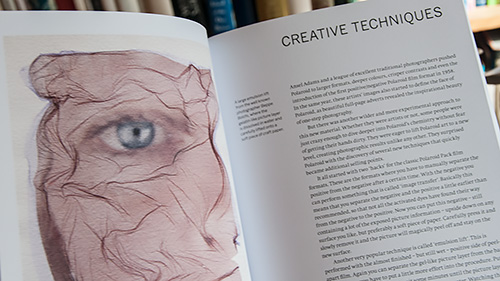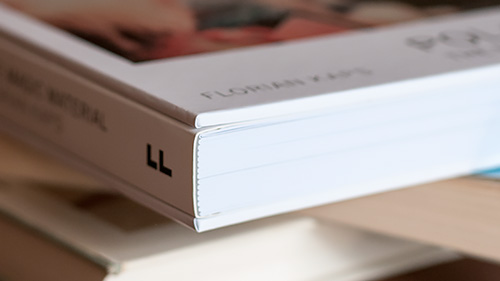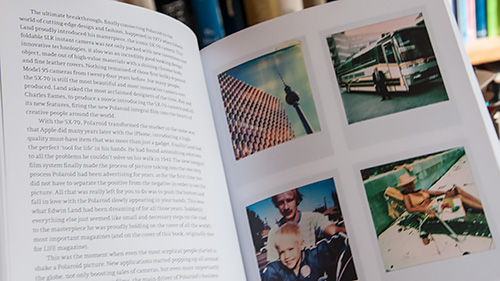Photo Corners headlinesarchivemikepasini.com
![]()
A S C R A P B O O K O F S O L U T I O N S F O R T H E P H O T O G R A P H E R
![]()
Enhancing the enjoyment of taking pictures with news that matters, features that entertain and images that delight. Published frequently.
Book Bag: Polaroid, The Magic Material




14 December 2016
Florian Kaps is one of the guys who founded the Impossible Project in 2008 after Polaroid announced it would stop making instant film. They leased the last Polaroid film factory and developed new instant film products for existing Polaroid cameras.

He tells the Impossible Project story in a 2014 interview with Markus Krennmayr. The name Impossible Project was, Kaps reveals, inspired by Polaroid management:
In all the discussions -- we negotiated for over a year -- they always said that it was impossible to continue production of instant film at the factory. I told them that I would call the firm "Impossible," but that they should simply give us a chance to try it. It was clear to everyone: if the machines and the factory were scrapped at any point, there would be no more possibilities to create this product.
Invited to the factory closing, he made friends with the production manager who believed instant film wasn't yet dead and was happy to conspire with him.
And after the FBI jailed most of the factory's management for tax evasion, he made friends with the remaining manager who could facilitate the transaction. And just like that he was in business.

The Book. The cover itself resembles a Polaroid print.
But Polaroid, The Magic Material is not just about the Impossible Project. It really is about Polaroid instant film photography, which Kaps fell in love with. Although he does admit to a more sinister motive:
This book aims to be different, not only entertaining and maybe educating you but also seducing you. I want to inspire you to make your own Polaroid picture soon, to shake it, carefully warm it under your arm if it is a cold day, watch it develop in the palm of your hand. And finally, when you have taken a few, to select your favourite one to become the visual highlight of this book.
There is, in fact, a page at the end of the book reserved for your own Polaroid. He isn't kidding.
But, Florian, we ourselves are well beyond any risk of seduction. We remember the stinky pink stick used to coat the contrasty black-and-white print. We remember timing the development before peeling the print free of the developer sheet. We remember the lousy cameras designed for photographers who had no patience for precision.

A Spread. Nicely laid out, giving the photographs center stage.
But those very attributes that annoyed us then and turn us off now are exactly what attracts a generation of digital snapshooters to the world of instant film photography.
And more power to them, we say.
They are creating one-of-a-kind prints. Even the old negative image, slathered in developer, was useless for creating more prints.
And, frankly, it isn't easy to scan a Polaroid, print it and match the color and tone of the original. We've tried it. A niece who shoots Polaroid for fine art prints sent us one as a gift once and we thought it would be nice of us to copy it for her. Talk about impossible.
Kaps' desire to seduce isn't the only unusual thing about this book, though. The binding is quite strange. It's a perfect bound paperback with a glued spine but the front and back covers are plastered with hardboard covers. You can see the construction in our photo.

The Binding. A paperback with hard covers.
As for the content, it's much more conventional. After the two-page introduction, it really is divided into two main parts titled Discovery and Re-Discovery, followed by a note about the photographs and the amusing (especially if you are married to Kaps) Dedication and Acknowledgements.
The difference between Discovery and Re-Discovery, which beings on page 128, exactly half-way through the 256-page book, is that Discovery focuses on Polaroid films and Re-Discovery focuses on the Impossible Project's story.

A Gallery. Various layouts are used to show off the work.
Despite Kaps' claim he only knows 527 different words in English, he is an entertaining writer who nevertheless manages to educate his reader. Whether or not he seduces you, you don't have to reveal.
After all, not everything you do has to see the light of day.
Polaroid, The Magic Material by Florian Kaps published by Frances Lincoln, 256 pages, $38.99 (or $24.69 at amazon.com).